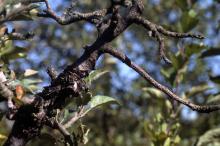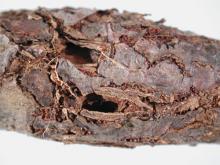Cause Neonectria ditissima (formerly Nectria galligena), a fungus. The disease is found primarily in high-rainfall areas along the coast and Willamette Valley and rarely in southern, central, or eastern Oregon. It has also been reported in western WA but not in Idaho. The canker is perennial. White fungal structures (sporodochia) appear on the canker either the first spring after infection or the next fall and winter. Round, red fungus bodies (perithecia) discharge another type of spore during the second winter and spring. Infection occurs during fall rains primarily through leaf scars but can also get in through wounds, pruning cuts, or where a young twig or branch has broken off. It has been suggested that the disease is a problem in locations where it rains more than 30% of the days of the month and there are at least 8 hours of temperatures between 52°F to 60°F.
The cultivars Braeburn, Gala, Gravenstein, King, Macoun, McIntosh, Red Delicious, and Spartan are very susceptible. The cultivars Golden Delicious, Honeycrisp, Jonagold, Jonathan, Northern Spy and Rome Beauty are less susceptible. Pear is susceptible but only when conditions are very favorable for disease development.
Symptoms Elliptical, sunken areas that are dark reddish-brown occur on year-old twigs around leaf scars. If or when girdled, the areas beyond the infection wilt and die. On older wood, infections look similar the first year but a callus forms around the infected area. The next year, the fungus invades and kills the new callus of the previous year. The result is a series of concentric calluses, one of which grows in the healthy tissue at the extreme margin of the canker each year. Cankers have a zonate appearance. The outer ring of the canker is irregular and roughened by cracks in the bark. Cankers can also be associated with various wounds such as from pruning.
This fungus can also infect fruit, causing the disease known as eye rot on the calyx end and bull's-eye rot at the lenticels similar to anthracnose and perennial canker.
Cultural control
- Cut out and destroy cankers during dry weather.
- Disinfect pruning shears during wet weather.
Chemical control Spray before fall rains for fruit rot control and during early, and again at mid to late, leaf fall for canker control. Fungicides protect leaf scars. May not be effective if not done in conjunction with canker removal.
- Captan 80 WDG at 3.75 lb/A. May be applied up to the day of harvest. Group M4 fungicide. 24-hr reentry.
- Copper-based products. O
- Bordeaux 8-8-100. If an earlier spray is applied for anthracnose control, an application for Nectria canker may not be necessary.
- C-O-C-S WDG at 8 to 15.5 lb/A plus dormant spray oil. 48-hr reentry.
- Cuprofix Ultra 40 Disperss at 8 to 20 lb/A. Postharvest only. 48-hr reentry.
- Kocide 50 DF at 12 lb/A. 48-hr reentry.
- Nu-Cop 50 DF at 12 to 16 lb/A. Do not use if soil pH is 5.5 or below. 48-hr reentry.
- Ziram 76 DF at 6 lb/A. Do not apply within 14 days of harvest. Group M3 fungicide. 48-hr reentry.
References Beresford, R.M. and Kim, K.S. 2011. Identification of regional climatic conditions favorable for development of European canker of apple. Phytopathology 101:135-146.
English, H., Dubin, H.J., and Schick, F.J. 1979. Chemical control of European canker of apple. Plant Disease Reporter. 63:998-1002.



